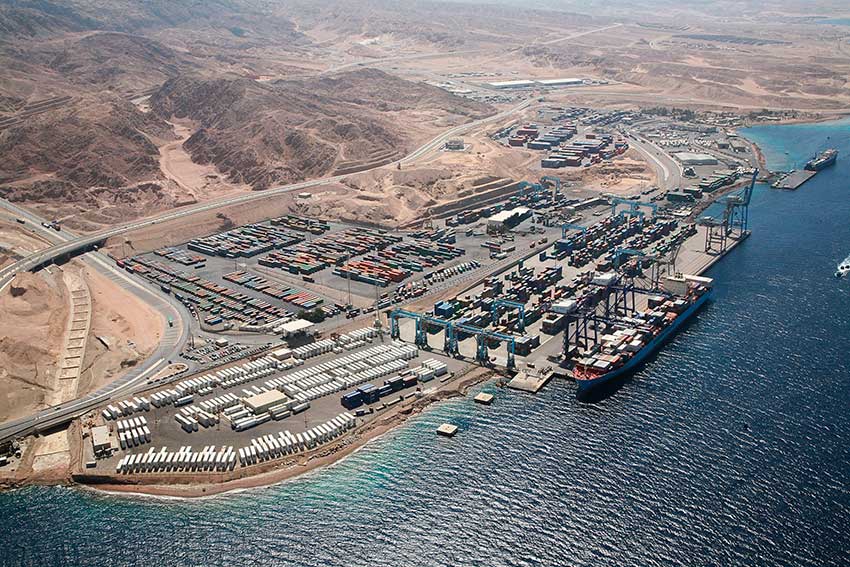Aqaba’s strategic importance for those that have ruled over it stretches back centuries. Almost a century on since the Battle of Aqaba, the expansion of Jordan’s only port is a key development for the Kingdom’s economy

Three hundred and twenty five kilometers from the Jordanian capital of Amman, on the northeastern tip of the Red Sea, lays Aqaba, a popular seaside resort and home to the Hashemite Kingdom’s only port, which serves as the heart of the town’s commercial industry and is the most sustainable gateway to Jordan and the surrounding region.
Aqaba’s strategic importance for those that have ruled over it stretches back centuries. It was one of the main ports for the Romans back in 106 AD and during Islamic rule around 630 AD, it became known as the “Door to Palestine”. In 1917 the Turks fought the Arab Revolt, led by Auda ibu Tayi and advised by Lawrence of Arabia, for control of the port—a battle in which the latter was victorious.
Almost a century on since the Battle of Aqaba and the port’s importance has not diminished. The town itself has grown out of the port and has become a thriving modern commercial and industrial hub—a result of the establishment of the Aqaba Special Economic Zone in 2000. The once tiny fishing village is now a modern city home to a fast growing population of 140,000 (2012 Census). With one of the highest population growth rates in Jordan, the figure is expected to swell to 250,000 by 2020. “Aqaba has a lot of potential and it was a must that it be developed to be a sort of a parallel development machine to Amman,” says Ghassan Ghanem, CEO of the Aqaba Development Corporation (ADC).
The tourism industry is growing at a similar trajectory to the population, and there are a number of sleek new infrastructure projects that are going to support the industry’s expansion, from five star hotels and a new Star Trek theme park, to the $10 billion dollar Marsa Zayed—a mixed-use waterfront project that includes high-rise residential towers, retail, recreational, entertainment, business and financial districts, and several hotels.
In order to strengthen Aqaba’s position as a modern logistic hub, the port itself has undergone a major transformation with the recent expansion of the Aqaba Container Terminal (ACT), a joint venture between ADC and APM Terminals, one of the world's leading container terminal operating and management companies. The $140 million berth expansion of the country’s only container terminal, which was completed in October 2013, is viewed by the government as a key development for the country’s economy. A further 460 metres were added to the existing 540-metre terminal—doubling the port’s capacity to 1.3 million TEUs (standard 20-foot containers) per year and allowing it to handle three vessels at a time. The draft (depth), key length and type of equipment that Aqaba Container Terminal invested in allows the largest vessels deployed on these trade routes to call Aqaba.
The berth expansion will help ACT to cope with the increasing throughput volume, which has more than doubled from 405,000 TEUs in 2006 (the year APM Terminalseffectively took control of the Container terminal) to 870,000 TEUs in 2013. While ACT’s CEO Jeppe Jensen points out that there was a 10% drop in volume in 2014 because of the ongoing turmoil in Syria and Iraq (a decrease which would have been much greater had it not been offset by the rise in domestic demand), he is very optimistic about the potential opportunities for ACT if the situation improves, particularly in Iraq, to which historically Aqaba has always been among the safest gateways for cargo.
“We have seen a downside because of the turmoil in the region. And what we are going to do to overcome that is develop a close relationship with the government. Because it means an increase in the need for infrastructure in particular when we are talking about the future and going into Iraq, which is something that we are relishing.”
On the topic of future opportunities in Jordan, Mr. Jensen envisages further expansion: “We have another opportunity to expand a further 200 meters and we will eventually also achieve that. APM Terminals is interested in participating in other investments in Jordan as well, be it infrastructure investment, logistics investment, or whatever other opportunities that would make business sense to the APM Maersk Group.”
Aside from the possible further expansion of the container terminal, the Port of Aqaba’s competiveness will be supported by two other projects this year: a liquefied petroleum gas (LPG) terminal that will increase the port’s LPG-importing efficiency; and Jordan’s first floating LNG import terminal, due to open in May. Gas will be pumped from both terminals through the Arab Gas Pipeline to power stations running on heavy fuel. This will lead to a reduction in generation costs which could in turn lead to a reduction in electricity tariffs for consumers. Along with the recent upgrading of an oil terminal that doubled its capacity to 15 million tons per year, these new gas terminals will also help to increase Jordan’s energy security.
0 COMMENTS